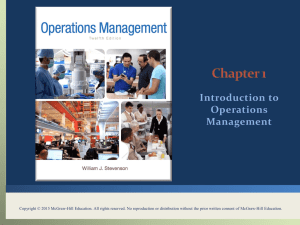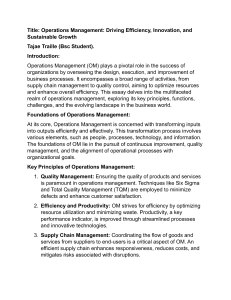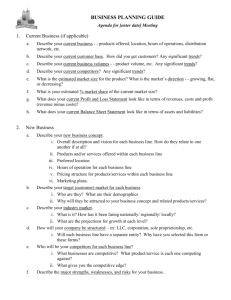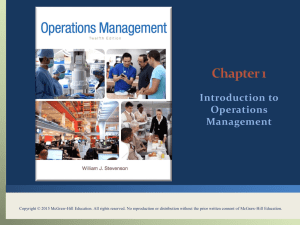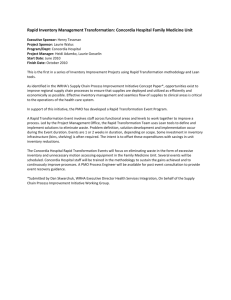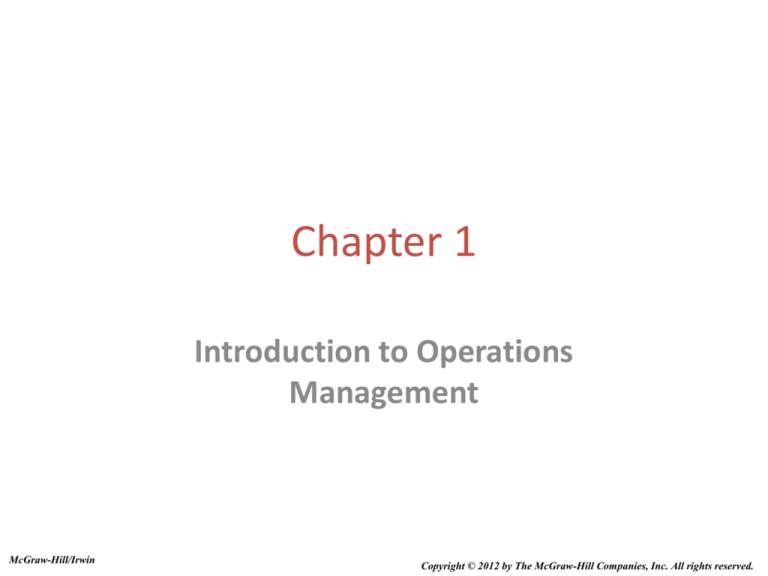
Chapter 1
Introduction to Operations
Management
McGraw-Hill/Irwin
Copyright © 2012 by The McGraw-Hill Companies, Inc. All rights reserved.
Chapter 1: Learning Objectives
You should be able to:
1. Define the term operations management
2. Identify the three major functional areas of organizations and describe how
they interrelate
3. Identify similarities and differences between production and service
operations
4. Describe the operations function and the nature of the operations manager’s
job
5. Summarize the two major aspects of process management
6. Explain the key aspects of operations management decision making
7. Briefly describe the historical evolution of operations management
8. Characterize current trends in business that impact operations management
Student Slides
1-2
Operations Management
• What is operations?
– The part of a business organization that is
responsible for producing goods or services
• How can we define operations management?
– The management of systems or processes that
create goods and/or provide services
Student Slides
1-3
Good or Service?
Goods are physical items that include raw materials, parts,
subassemblies, and final products.
•Automobile
•Computer
•Oven
•Shampoo
Services are activities that provide some combination of time, location,
form or psychological value.
•Air travel
•Education
•Haircut
•Legal counsel
Student Slides
1-4
Supply Chain
Supply Chain – a sequence of activities and
organizations involved in producing and delivering
a good or service
Suppliers’
suppliers
Student Slides
Direct
suppliers
Producer
Distributor
Final
Customers
1-5
The Transformation Process
Value-Added
Inputs
•Land
•Labor
•Capital
•Information
Transformation/
Conversion
Process
Outputs
•Goods
•Services
Measurement
and Feedback
Measurement
and Feedback
Control
Measurement
and Feedback
Feedback = measurements taken at various points in the transformation process
Control = The comparison of feedback against previously established
standards to determine if corrective action is needed.
Student Slides
1-6
Manufacturing vs. Service
1. Degree of customer contact
2. Uniformity of input
3. Labor content of jobs
4. Uniformity of output
5. Measurement of productivity
6. Production and delivery
7. Quality assurance
8. Amount of inventory
9. Evaluation of work
10.Ability to patent design
Student Slides
1-7
Scope of Operations
Management
The scope of operations management ranges across
the organization.
The operations function includes many interrelated activities
such as:
Forecasting
Capacity planning
Facilities and layout
Scheduling
Managing inventories
Assuring quality
Motivating employees
Deciding where to locate facilities
And more . . .
Student Slides
1-8
Role of the Operations Manager
The Operations Function consists of all activities directly related
to producing goods or providing services.
A primary function of the operations manager is to guide the
system by decision making.
– System Design Decisions
– System Operation Decisions
Student Slides
1-9
Why Study OM?
• Every aspect of business affects or is affected by operations
• Many service jobs are closely related to operations
–
–
–
–
Financial services
Marketing services
Accounting services
Information services
• There is a significant amount of interaction and collaboration
amongst the functional areas
• It provides an excellent vehicle for understanding the world in
which we live
Student Slides
1-10
OM and Supply Chain
Career Opportunities
•
•
•
•
•
•
•
•
•
Operations manager
Supply chain manager
Production analyst
Schedule coordinator
Production manager
Industrial engineer
Purchasing manager
Inventory manager
Quality manager
Student Slides
1-11
Decision Making
Most operations decisions involve many alternatives that can have quite
different impacts on costs or profits
Typical operations decisions include:
What: What resources are needed, and in what amounts?
When: When will each resource be needed? When should the work be
scheduled? When should materials and other supplies be ordered?
Where: Where will the work be done?
How: How will he product or service be designed? How will the work be
done? How will resources be allocated?
Who: Who will do the work?
Student Slides
1-12
Historical Evolution of OM
•
•
•
•
•
Industrial Revolution
Scientific Management
Human Relations Movement
Decision Models and Management Science
Influence of Japanese Manufacturers
Student Slides
1-13
Key Issues for Operations
Managers Today
•
•
•
•
•
Economic conditions
Innovating
Quality problems
Risk management
Competing in a global economy
Student Slides
1-14
The Need for Supply Chain Management
• In the past, organizations did little to manage
the supply chain beyond their own operations
and immediate suppliers which led to
numerous problems:
– Oscillating inventory levels
– Inventory stockouts
– Late deliveries
– Quality problems
Student Slides
1-15

